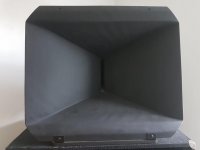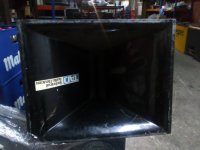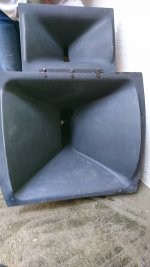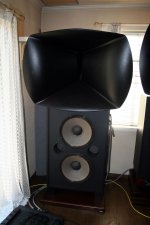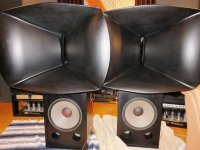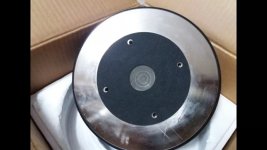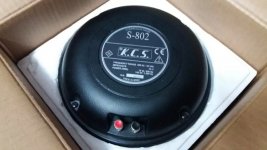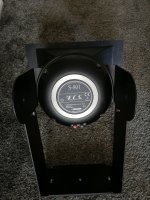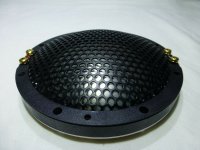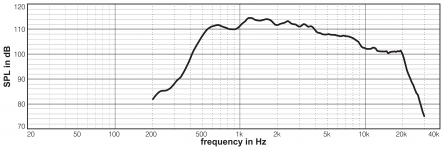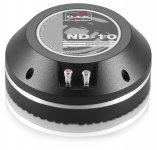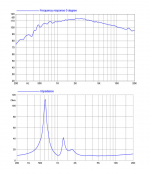Here's a quite big horn, I asked the Czech dealer if possible to buy only the horn. Wonder if they use RCF 950 driver in it...
http://kcsspeakers.com/pdf/S-5000.pdf
http://kcsspeakers.com/pdf/S-5000.pdf
Spanish variation of the JBL Bi-Radial range of cinema horns (2360A, 2365A, 2366A).
Others brands that offer(ed) similar horns:
- Klipsch
- Krix
- TAD (made by Community)
- Sony
- a number of Asian brands.
Others brands that offer(ed) similar horns:
- Klipsch
- Krix
- TAD (made by Community)
- Sony
- a number of Asian brands.
Klipsch, early TAD, later TAD, Sony:
Attachments
Last edited:
The Sony horns are really large format, they dwarf the 18s below.
Attachments
Last edited:
Wonder if they use RCF 950 driver in it...
KCS uses mostly D.A.S.
The S-5000 that Peter posted has this driver behind it's horn, which is more akin to JBL's 2360 compared to the mid-horn in the S-8000.
Evidently, the horn in the picture much smaller.
Evidently, the horn in the picture much smaller.
Attachments
Last edited:
It's the diaphragm of this driver, the response curve of which looks similar to drivers with Beryllium diaphragms. The lack of break-up is too good to be true, given the fact where dealing with a plain old 4" Titanium diaphragm here.
Attachments
Last edited:
What I use is based on a kit called Decorator (no more available) by Wolf v. Langa. This is an open baffle but the acoustic short is gretaly reduced. I currently use it as an 2.5 way. The horn part opens up several options for this speaker. Currently a round horn is running and another biradial is under investigation. In this configuration the speaker is flat to 40 Hz without any baffle resonances.
In order to cross over at lower frequencies one of the best drivers on the market is used: the 18s ND4015Be.
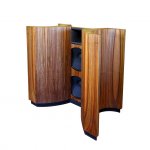
ND4015Be @ LTH142 horn (FR):
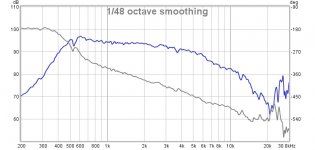
ND4015Be @ LTH142 horn (spectrum):
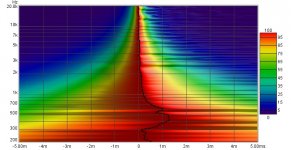
Measurements were done @mouth slightly asymmetric with an Earthworks M23 microphone. It is hard to find a better micro for this price tag.
In order to cross over at lower frequencies one of the best drivers on the market is used: the 18s ND4015Be.

ND4015Be @ LTH142 horn (FR):

ND4015Be @ LTH142 horn (spectrum):

Measurements were done @mouth slightly asymmetric with an Earthworks M23 microphone. It is hard to find a better micro for this price tag.
Interesting how much the LTH142 improves the driver's response above 10 kHz or does this measurement include the mid-bass horn's impact on it?: Test Bench: Eighteen Sound ND4015BE Beryllium Compression Driver | audioXpress
GM
GM
Interesting how much the LTH142 improves the driver's response above 10 kHz or does this measurement include the mid-bass horn's impact on it?: Test Bench: Eighteen Sound ND4015BE Beryllium Compression Driver | audioXpress
GM
I was always confused by these measurements in the Voice Coil magazine. My drivers are from an actual production lot.
Here are three other horns for this driver:
18s own horn XT1464 with adapter 1.5 to 1.4:
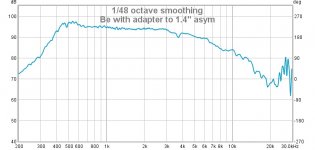
Stereolab SL400Hz:
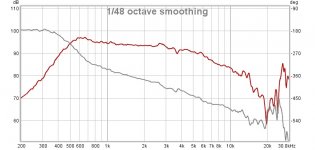
Selenium HL4750SLF 40x20:
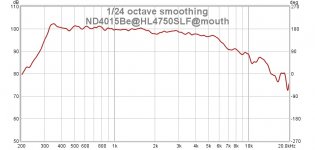
The LTH142 is the smoothest but the Selenium is the best of all. It has the least beaming and by far the best low frequency extension and a first listening was very promising. This opens up the possibility for a much lower cross-over point.
And how properly the Selenium loads this driver can be seen here:
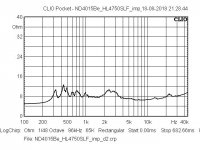
What a well designed driver and diaphragm. The copper shorting ring does it's job as the impedance raise is nearly neglectable up to 20 Khz.
In the sense of this thread this driver is definitively a proven way to go for a 2-way set-up.

What a well designed driver and diaphragm. The copper shorting ring does it's job as the impedance raise is nearly neglectable up to 20 Khz.
In the sense of this thread this driver is definitively a proven way to go for a 2-way set-up.
I would say: the Selenium may not be the smoothest, but it's the most consistent as far as output is concerned.
The ripples are due to the round to rectangular transition and the mouth.
The Selenium will sound best, both throughout the midrange as well as the top octave.
The ripples are due to the round to rectangular transition and the mouth.
The Selenium will sound best, both throughout the midrange as well as the top octave.
Last edited:
Fortunately, I had the chance to measure the same driver from a german friend. with TiN (TPM) diaphragm NSD4015N and compare it to the Be version.
What is not obvious from the frequency response that all Ti and Al diaphragm with such a large diameter diaphragm suck from 10Khz on. You have level but huge break-up modes and therefore distortions. Not really usable for high end.
Be has smoother frequency response:
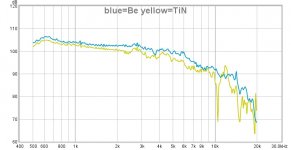
TiN has a sudden increase of 2nd and 3rd order distortions from 10k on:
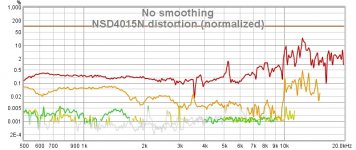
Be has very consistent distortions and stays within reasonable numbers above 10k. Break-up mode is around 26k:
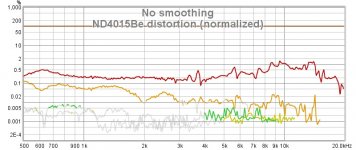
What is not obvious from the frequency response that all Ti and Al diaphragm with such a large diameter diaphragm suck from 10Khz on. You have level but huge break-up modes and therefore distortions. Not really usable for high end.
Be has smoother frequency response:

TiN has a sudden increase of 2nd and 3rd order distortions from 10k on:

Be has very consistent distortions and stays within reasonable numbers above 10k. Break-up mode is around 26k:

Fortunately, I had the chance to measure the same driver from a german friend. with TiN (TPM) diaphragm NSD4015N and compare it to the Be version.
What is not obvious from the frequency response that all Ti and Al diaphragm with such a large diameter diaphragm suck from 10Khz on. You have level but huge break-up modes and therefore distortions. Not really usable for high end.
Be has smoother frequency response:
View attachment 768685
TiN has a sudden increase of 2nd and 3rd order distortions from 10k on:
View attachment 768686
Be has very consistent distortions and stays within reasonable numbers above 10k. Break-up mode is around 26k:
View attachment 768687
Comes with a price tag of 1500Euro/piece 😱)
- Home
- Loudspeakers
- Multi-Way
- Is it possible to cover the whole spectrum, high SPL, low distortion with a 2-way?
